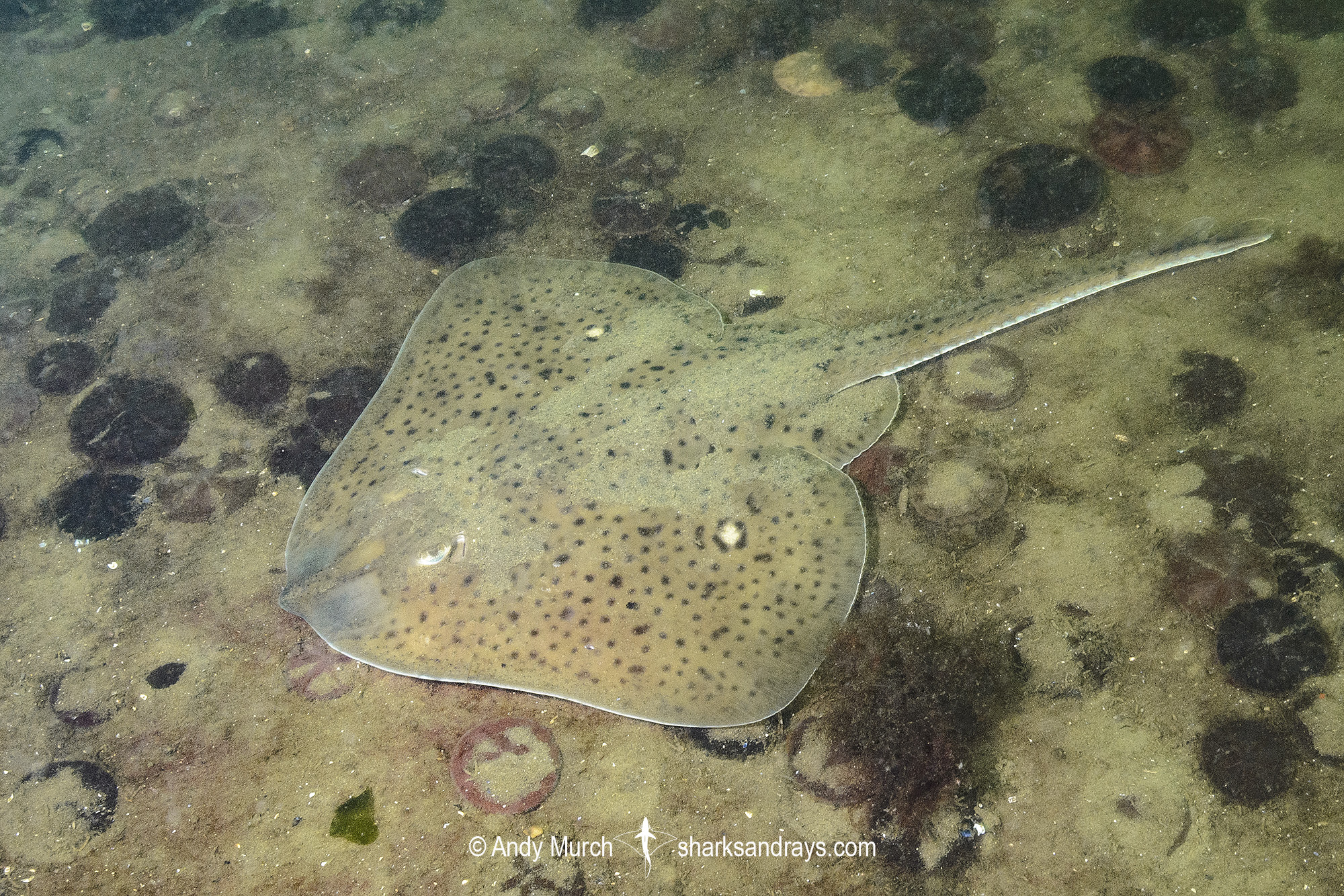Common name(s)
Winter Skate.
Identification
A large skate with a heart-shaped or rounded kite-shaped disc. Disc width 1.3 x disc length. Snout broadly rounded or obtusely angular with a small protruding tip. Snout length 2.6-3.3 x orbit length. Anterior margins of pectoral fins undulate; double convex with a weak central concavity; undulation exaggerated in adult males. Pectoral apices broadly rounded. Dorsal surface without small denticles. Dense patches of thorns and/or spinules present on snout, around eyes, nape, along disc margin, and in a strip along either side of midline. Median row indistinct in adults. Tail with 5 lateral thorn rows, median row absent in adults. Pelvic fins weakly notched. Anterior pelvic lobe much shorter than posterior lobe. Tail tapers gradually to tip. Dorsal fins confluent and broadly rounded.
Colour
Dorsum light brown or grey-brown with numerous small dark spots and 1-4 white or pale ocelli ringed by small black spots. Ventrum white, sometimes with irregular dark blotches posteriorly.
Size
Maximum length 113cm. Egg case length 6-8cm. Length at hatching 11-13cm.
Habitat
Temperate seas. Demersal on sand or gravel substrates, occasionally on mud and rock. From 5-725m.
Distribution
Northwest Atlantic. Found from North Carolina, USA to Labrador, Canada. Disjunct concentrations of winter skates are found in the Gulf of St Lawrence, the southern Grand Banks/Northeast Scotian Shelf, and southwest Scotian Shelf/all areas south.
Conservation Status
ENDANGERED
The Winter Skate (Leucoraja ocellata) is captured in demersal trawl, longline, and gillnet fisheries. Like many skates, this species has a slow life history, particularly in the part of its Canadian range where it matures at 13 years and has a generation length of 17 years. In the USA, it is a major component of the skate wing fishery, taken as bycatch of demersal trawl and gillnet fisheries. In Canada, it is a discarded bycatch (mandated by legislation) of demersal trawl, longline, and net fisheries. Historically, this species underwent very steep declines coinciding with high levels of demersal fishing from international fleets targeting shelf and slope groundfish. The extension of Exclusive Economic Zones out to 200 nautical miles in 1977 restricted fishing access to USA and Canadian vessels. Effort was renewed on skates in the late 1980s and early 1990s, with the encouragement of directed fisheries as other groundfish fisheries collapsed in USA and Canadian waters and as international demand for skate wings increased. In the southern part of its USA range, the annual population growth rate is increasing at a rate of 2% per year and the stock is sustainably fished, assessments revealed that the stock is not being overfished and that overfishing is not occurring. In stark contrast, there have been very steep reductions in Canadian waters, of 98.2%, 98.3% and 90.6%, in the southern NW Atlantic (Northeastern USA, Georges Banks, Canada/Gulf of Maine, USA (5Z), Scotian Shelf and Bay of Fundy, Canada (4VWX) and Southern Gulf of St. Lawrence (4T), respectively. The directed commercial skate fishery on the Grand Banks and Scotian Shelf was closed in 2004 and all Winter Skate were to be discarded, and discard rates were to be monitored. Predation from recovering populations of Grey Seal (Halichoerus grypus) is estimated to have caused high levels of adult mortality in the Gulf of St Lawrence and which may be inhibiting recovery there. Overall, the combination of very steep estimated population reduction in the bulk of this species’ distribution in Canada is partially offset by the sustainably managed and increasing fraction of the species range in USA waters, and it is estimated that this skate has undergone a population reduction of 50–79% over the past three generations (51 years). Therefore, the Winter Skate is assessed as Endangered A2bd.
Citation
Kulka, D.W., Anderson, B., Cotton, C.F., Derrick, D., Pacoureau, N. & Dulvy, N.K. 2020. Leucoraja ocellata. The IUCN Red List of Threatened Species 2020: e.T161631A124518400. https://dx.doi.org/10.2305/IUCN.UK.2020-3.RLTS.T161631A124518400.en. Downloaded on 24 April 2021.
Reproduction
Oviparous. Females produce 18-36 egg cases per year. Reproduction occurs year round. Sexual maturity among winter skates occurs at vastly different ages in different regions. In the Gulf of Maine, female age at maturity is 5yrs and have an average life expectancy of 11yrs. Further north on the Scotian Shelf and waters east of the St Lawrence Estuary, females mature at ~13yrs and live until 19yrs.
Diet
Winter skates feed mostly on crustaceans, squids, and bony fishes.
Behavior
Moves inshore during the colder months; hence common name.
Reaction to divers
Somewhat skittish. Some winter skates will tolerate a close approach if attempted very slowly and indirectly i.e. approaching at an angle as if heading past. Rarely stays put once directly engaged.
Diving logistics
Winter skates are quite common off of shallow bays in New England. They are apparently most common in the winter months but I have seen numerous animals during dives in June and August.
A good spot to encounter winter skates is at Back Beach near Rockport on the Cape Ann Peninsula, Massachusetts. Diving off Back Beach is a simple matter of walking in off the beach and kicking out to 10-15m depth while keeping a close eye on the sand.
I have also encountered numerous winter skates in August off of Fort Adams, Newport, Rhode Island.
What’s new
View our full list of updates
Similar species
Little Skate Quite similar in shape and coloration but distinguishable by lack of white centred ocelli on pectoral fins.







